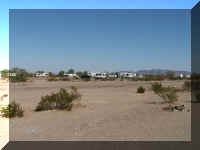 That
is our HHII in the middle of the photograph. We were in Quartzsite on October 31.
Well ahead of the people arriving to spend the winter.
That
is our HHII in the middle of the photograph. We were in Quartzsite on October 31.
Well ahead of the people arriving to spend the winter.Arizona - 2006 (Eastbound)
Updated: 11/30/08
Commemorative Air Force - Arizona Wing
Casa Grande Ruins National Monument
Saguaro (Cactus) National Park - West
Anyone who reads RV magazines knows about Quartzsite, Arizona. Several articles have detailed the story of thousands of RVers who spend their winter in the Quartzsite area. The communities they develop. Returning to the same camping area year after year.

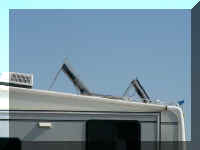
The campground we used is called "Hi Jolly" and has a 14-day limit. Other public land campgrounds (operated by the U. S. Department of Interior, Bureau of Land Management) have 30, 60 or 90-day limits with permit. The campground host told us that later in the winter, it would be difficult to find a spot to park your RV in "Hi Jolly". When your 14 days is up, you can leave for 25 days and return or move between the types of sites if a spot was available. There are no hookups, water or dump in desert camping. All are available in town. In addition, there are many private campgrounds with hookups - for a fee.
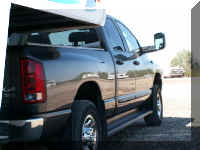
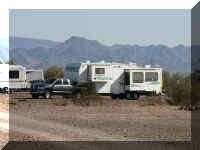
Commemorative Air Force - Arizona Wing

Like many military planes, this one has a name and a figure painted on the nose.
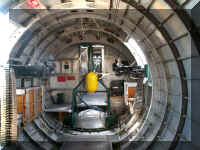
The cockpit looks a little stark also.
In combat, the plane needed protection for all angles. There are guns front, rear, both sides, top and bottom. We had the privilege of speaking with a gentleman who flew 30 missions as the pilot in a plane like this during WWII. He showed us some photographs from his album, including his crew and some photographs taken by his gunner from the bubble with a brownie box camera during combat flights.
The museum had a large hanger with several planes on display.
Another hanger was used to restore planes. One of the planes had been in various phases of restoration for twenty years.
The admission fee was a donation of $7 per person. Plan on spending at least two hours looking at the planes and static displays.
Casa Grande Ruins National Monument
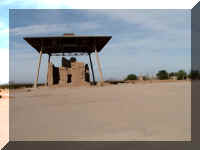
Ancient builders found construction material in the subsoil beneath their feet - caliche, a concrete-like mixture of sand, clay and limestone. They ground the rock and made a mud out of it. It took 3,000 tons of caliche mud to construct the Great House. The mud was piled in successive courses to form walls 4 feet thick at the base, tapering toward the top. Trees were brought from 60 miles away to form the ceiling and floor supports.
The four faces of Casa Grande . . .
It's four walls face the four point of the compass. A circular hole in the upper west wall aligns with the setting sun during the summer solstice. Other openings also align with the sun and moon at specific times. Knowing the changing positions of celestial objects meant knowing times for planting, harvest and celebrations.
There is no public access to the inside but missing exterior walls and two doorways let you peak inside.
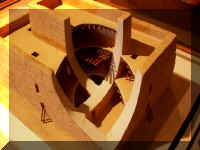
The visitor center displayed many of the items found during archeological digs including this olla. All of the ruins have not been excavated. Many artifacts are yet to be found.
Here you can see the outline and remains of other structures used by the 'neighborhood'. Casa Grande is the largest structure in this particular 'neighborhood'.
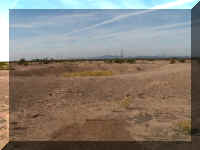
Admission to Casa Grande was $5 per person. Allow an hour to visit the grounds, view the displays and watch the video.
Saguaro (Cactus) National Park - West
We arrived late in the day at the Saguaro National Park. The distance from I-10 was only 15 miles. But, the road was a little rough and a lot dippy. This left us less than a desirable amount of time to do the Cactus Forest Drive circle tour and the Desert Discovery walking trail that looked interesting on the park map.
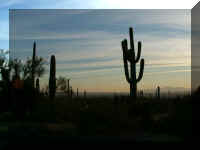
After the video ended, the screen was raised and this was the view out the window behind the screen.
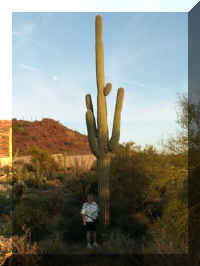
We set up camp before dark. This is the view from our window.
The next morning we drove the eight mile Cactus Forest Drive. We saw cactus of all shapes, of all sizes, of all ages, of all conditions of health and some dead cactus.
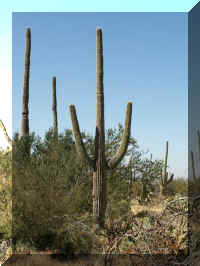
As we drove we decided we had different interest. Mary Lou was in awe at the sheer number of cacti. She appreciated the variety of shapes and sizes. Fred was interested in the cycle of life and looked for damaged, dying or dead cacti.
Regardless of your interest, the Cactus Forest Drive is a 'must do' when you visit the park
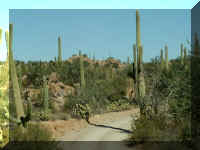
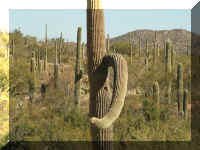
Others had interesting, unusual or funny shapes.
Whatever the cause for their demise, it is a natural event. Cacti are threatened by lightning and wind, old age, and severe droughts and humans. These have been injured. Sometimes the injuries are fatal.
This cactus looks like it fell over, withered and died. It was one of the more interesting sights alongside the loop road because it is so unusual - not in nature, but to us. We explained it to the ranger and she said it was very difficult to tell how long it was laying on the ground - it probably fell sometime this year.
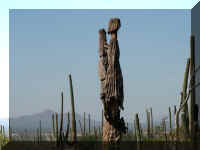
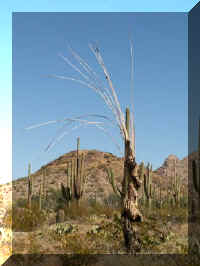
Many cactus seeds are produced, few result in a new cactus plant. The seeds that have the best chance of survival are those who are under 'nurse' plants. They are protected.
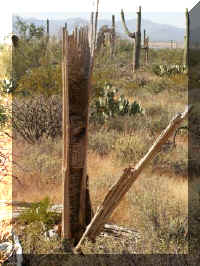
In the Saguaro National Park, a wet desert, size and age relationships of cactus are approximately as follows:
Height: Age in years:
1 inch 6 - 7
1 foot 17
3 feet 26
6.5
feet
36
& flowers
15 - 18 feet 55 - 60
46 feet 173
At about 75 years it may sprout its first branches, or arms. The branches begin as prickly balls, then extend out and upward. Saguaros that live 150 years or more attain the grandest sizes, towering 50 feet and weighing 8 tons. These are the largest cacti in the United States.
Admission to the park was $7 per person.
Mesa, AZ has landscaped their freeways.
A church in Mesa
Cotton field and cotton bale the size of a semi-trailer
Cactus can be seen along the road.
Dust storm . . .
City initial on mountains . . .
Rest area sign . . .
We see a lot of container trains in the southwest.